-
-
Access Free Student Software
Ansys empowers the next generation of engineers
Students get free access to world-class simulation software.
-
Connect with Ansys Now!
Design your future
Connect with Ansys to explore how simulation can power your next breakthrough.
Countries & Regions
Free Trials
Products & Services
Learn
About
Back
Products & Services
Back
Learn
Ansys empowers the next generation of engineers
Students get free access to world-class simulation software.
Back
About
Design your future
Connect with Ansys to explore how simulation can power your next breakthrough.
Free Trials
ANSYS BLOG
July 22, 2022
When Science and Simulation Amplify the Amazing Exploits of Elite Cyclists
The last three weeks have been phenomenal for the elite cycling world, with what many describe as the most beautiful, exciting, and stressful Tour de France of the last few decades. The Tour de France is without doubt the most difficult and prestigious cycling race in the world today. It has a track record of exceptional cyclists who have made cycling history. Winning this race is the dream of every elite cyclist and the career highlight of the few who reached this lofty goal.
So, it is not a surprise that all competing teams dedicate so much time and energy to get ready for the extreme challenge of the race, which covers more than 3,350 km (2,220 miles), many of them in the mountains, in 23 days. The preparation obviously includes intense physical and mental training for the athletes, combining endurance, extreme performance, and strong mental resilience to keep fighting despite all difficulties.
The teams also carefully study the route and the weather conditions to know when to take the lead or stay back in the pack. But all this is not enough anymore. For more than a decade, science — and especially simulation — have played important roles in guiding the top cyclists to victory.
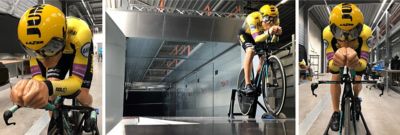
Elite athletes of Team Jumbo Visma benefit from a combination of wind tunnel and CFD analyses performed by TU/e.
I have always been impressed by the level of preparation of the teams we have the privilege to work with. But today, I would like to highlight the extreme professionalism of Team Jumbo-Visma. They have been working with the best experts in the world, such as Professor Bert Blocken, a world-class expert in athletic aerodynamics of the Eindhoven University of Technology (TU/e) and KU Leuven. Blocken and his team use Ansys Fluent extensively in combination with wind tunnel experiments to assess and improve air penetration and reduce induced drag for cyclists bunched up in a group, or peloton. Team Jumbo Visma’s attention to each detail led them to:
- Investigate and adjust the position of cyclists on their bikes for different wind directions and speeds
- Alter the relative positions of athletes in a group during the race to reduce the drag experienced by the cyclists
- Assess the contribution of each component of the bike, the equipment, and the athlete
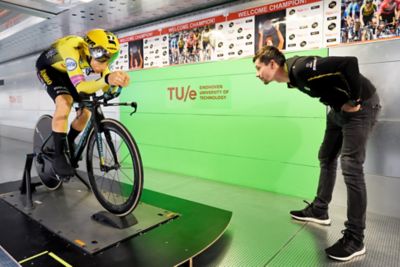
Primoz Roglic inspects his mannequin.

Wout van Aert poses with his doppelganger.
“Richard Plugge and everyone in Team Jumbo-Visma have created a top cycling team based on quality, friendship, respect, team spirit and science,” says Blocken. “As scientists, certainly in sports, we always need to be modest. We as universities, supported by our partner Ansys, are just a small piece of a very large, complex puzzle. But when the whole puzzle fits, great things can happen.”
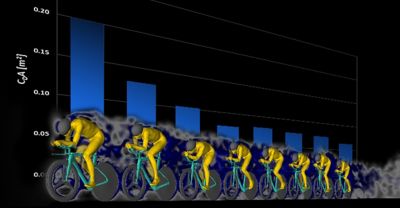
Analysis of the aerodynamic performance of sequences of Team Jumbo-Visma riders for the Team Time Trial in the 2019 Tour de France using Ansys Fluent computational fluid dynamics. Team Jumbo-Visma won the time trial.
Improving Athletic Aerodynamics
Modeling the aerodynamics of cyclists to provide valuable insight into performance is an extremely challenging task in which accuracy is critical. Modifying some components of the “athlete–bike” system usually results in drag reduction ranging from less than one percent up to a few percent. Using a less accurate model, not sufficiently validated by experimental measurements in a wind tunnel, could yield misleading recommendations that increase the drag and waste an athlete’s energy, which could lead to the loss of precious seconds at the finish line.
With his two decades of experience in fluid flow modeling and the most recent turbulence models available in Fluent, Blocken has extensively validated his aerodynamics modeling protocol as applied to group cycling in a race. His team performs scans of the athletes’ bodies to ensure that their exact physical shapes are included in the simulation. Then they run numerous simulations to evaluate the drag on each member of the team as necessary, including each cyclist’s body position, wind conditions, etc. When the simulations are optimized, they present the results and discuss them with the team and the athletes to develop a plan for that day’s race stage.
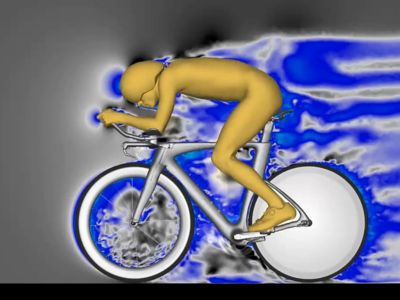
Detailed and validated computational fluid dynamics simulation provides invaluable insights on the drag induced by different components and parts of the cyclist’s body.
The capacity of these elite cycling athletes to endure the stress, strain, and pain of racing over 3,350 km in 23 days was bought home to me in December 2020, when I had the chance to talk with Wout van Aert. He is a hero of the 2022 Tour de France and winner of the green jersey, which is awarded to the daily leader in race points. When I suggested that we could mathematically optimize his position on the bike while also taking his comfort into consideration, Wout impressed me by requesting, in a humble and professional way, that we should simply show him the best mathematical position and he would adjust to it. Comfort was secondary.
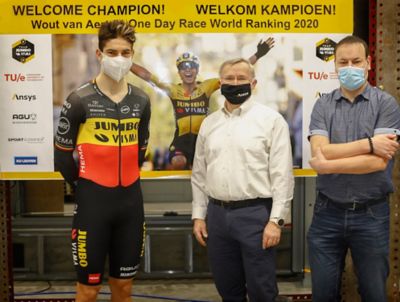
From left to right: Wout van Aert, a legend of the 2022 Tour de France, Thierry Marchal of Ansys, and Bert Blocken met in December 2020 to discuss ways to further improve cycling aerodynamics.
Congratulations to Team Jumbo-Visma
Cycling is known as the individual sport where team play is most important. Riders on the same team work together to help their best rider win the Tour de France, sacrificing their chance at personal glory by contributing to the team’s win. It is appropriate that the motto of Team Jumbo-Visma is “Samen winnen” (winning together).
After his fantastic victory at the top of Hautacam, one of the steepest Pyrenean roads in this 2022 Tour de France, Jonas Vingegaard, Team Jumbo-Visma leader and winner of the 2022 Tour de France, stressed the importance of teamwork, thanking his teammates who helped him in the race over the course of the 23 days. But his team reaches beyond his fellow cyclists to include the extended Team Jumbo Visma at large, including coaches, trainers, medical professionals, logistics experts, and many more who work behind the scenes.
We at Ansys are proud to be one of many collaborating companies to make a modest contribution to Team Jumbo-Visma’s amazing success through the simulation work of Bert Blocken.
We would like to congratulate Jonas Vingegaard, Wout van Aert, and all the members of Team Jumbo- Visma for the fantastic achievement of winning the 2022 Tour de France. We are looking forward to ongoing collaboration with them through the work of Blocken and his team to achieve continuing success in the next few years.